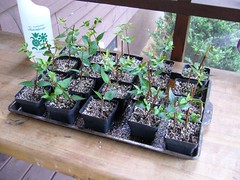 Two large abelia plants have grown near the entrance of my family home as far back as I can remember. Photos show them already mature when my parents bought the house in 1949.
Two large abelia plants have grown near the entrance of my family home as far back as I can remember. Photos show them already mature when my parents bought the house in 1949.Since we now have the house under contract and are in the process of clearing it out and cleaning up, I wanted to take with me a remembrance or two of our yard. Some of dad's Zoysia grass is already plugged into my backyard. These rootings are from one of the abelias. Friendly folks at a local nursery got them started for me and they seem to be doing just fine. In a couple of years they will be ready to transplant. I feel better every time I look at them.
From Wikipedia:
Abelia is a genus of about 15-30 species and many hybrids in the honeysuckle family Caprifoliaceae, in the part of that family split off by some authors in the segregate family Linnaeaceae. The Angiosperm Phylogeny Group considers Linnaeaceae to encompass such genera as Linnaea, Abelia, Dipelta, Kolkwitzia, and Zabelia.Abelias are a wonderful plant. They tolerate a variety of soils and climates, stay green year round, don't shed leaves in the fall (around here), have pleasant small flowers with a mild fragrance, and provide habitat for the birds and the bees. They come in many varieties, including the smallish Little Richard (Good Golly Miss Molly!!!) I am already using as foundation plants. These are probably an older variety of grandiflora (Abelia Edward Goucher?). But as usual, I could be wrong.
Abelias are shrubs from 1-6 m tall, native to eastern Asia (Japan west to the Himalaya) and southern North America (Mexico); the species from warm climates are evergreen, and colder climate species deciduous. The leaves are opposite or in whorls of three, ovate, glossy, dark green, 1.5-8 cm long, turning purplish-bronze to red in autumn in the deciduous species. The flowers appear in the upper leaf axils and stem ends, 1-8 together in a short cyme; they are pendulous, white to pink, bell-shaped with a five-lobed corolla, 1-5 cm long, and usually scented. Flowering continues over a long and continuous late spring to fall period.
No comments:
Post a Comment